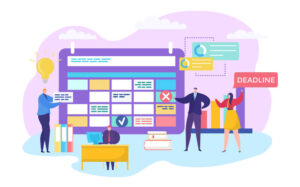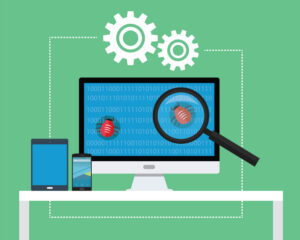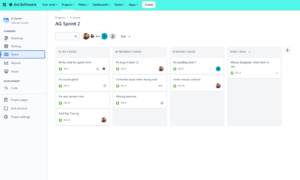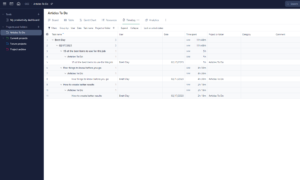Key Takeaways: SAFe Core Values
- To scale Agile methods effectively using SAFe, every member of the organization must embrace the four SAFe core values: alignment, built-in quality, transparency and program execution.
- The SAFe framework incorporates many aspects of Lean, which helps improve efficiency and reduce waste.
- SAFe can scale Agile methodologies and frameworks such as scrum, kanban and XP.
Scaling Agile project management methodologies and frameworks has always been complicated; however, it’s not impossible. Thanks to SAFe and the four SAFe core values, organizations can create a company-wide development team and still benefit from highly adaptable and collaborative Agile frameworks such as scrum and Extreme Programming.
In this guide, we’ll look at SAFe’s four core values. You’ll learn what they are, their impacts on teams and how you can use them to scale Agile in your organization.
What Is SAFe (Scaled Agile Framework)?
SAFe, which stands for “scaled Agile framework,” is a set of values and principles that helps organizations scale Agile development teams.
Think of it like this: scrum is a framework based on Agile values for small teams. Because scrum (and other Agile methodologies, like XP) demand face-to-face meetings, such as sprint retrospectives and sprint reviews, making large Agile teams can be challenging.
With the SAFe framework, organizations can mold multiple small Agile groups into one cohesive, organization-wide team that can work on one large, complex project simultaneously. The SAFe framework calls for leaders with a Lean-Agile mindset, Lean portfolio management competency and teams that offer rapid and flexible response times.
In other words, SAFe takes Agile methodologies and mixes them with Lean principles, turning them into organization-wide frameworks that are still flexible, champion direct lines of communication, increase efficiency, reduce waste and value high-quality work.
What Are the SAFe Core Values?
Like Agile (see the Agile Manifesto), SAFe, which uses Lean and Agile principles, has four core values that must always be respected. Below, we’ll cover the four core values that any team using the SAFe method should follow.
Alignment
One of the most important core values is alignment. When organizations decide to scale Agile, they must ensure that every team working on the same project is aligned.
If any part of the team is out of sync, it could spell disaster. Fortunately, SAFe defines the most important roles within each team, events and when they should be held, and processes, all of which help multiple teams stay on the same page.
Built-in Quality
SAFe champions quality every step of the way. Unlike some project management methodologies, where quality checks are completed at the end of development, quality checks in SAFe are made throughout the process.
SAFe ensures that quality is where it needs to be by breaking built-in quality down into five categories: flow, architecture and design quality, system quality, code quality and release quality. The built-in quality checks ensure an organization’s work is accurate. The consequences of not checking an organization’s work quality until the end of a development process would be dire.
Transparency
Anyone who has worked in Agile development can tell you that transparency is one of the keys to success. Transparency increases employee engagement and helps build trust, and teams who trust each other are happier and more efficient.
The SAFe framework ensures that work logs are available to management and key stakeholders. Agile Release Trains (ARTs) — a cross-functional team working toward a common goal — also has access to backlogs.
Metrics covering work in progress (WIP) and team velocity are also available. This level of transparency allows all teams to see and address issues before they become major problems.
Program Execution
One of the four core values found in the Agile Manifesto states that working software is more important than comprehensive documentation. This is where the core value of program execution found in SAFe comes from.
An Agile team that consistently produces working software can improve business outcomes and drive business value, leading to increased client satisfaction.
The three other core values (alignment, built-in quality and transparency) reinforce program execution within the SAFe framework. Each value is crucial in helping teams improve overall quality standards and business outcomes.

What Are the Benefits of the SAFe Core Values?
The SAFe framework, with its principles and values, offers many benefits. SAFe can increase engagement by encouraging teams to collaborate. The Lean principles in play also help create a structure that can increase product quality, reduce waste and help products reach the market faster by helping teams achieve flow (the process of quickly and efficiently delivering products).
How to Adhere to the SAFe Core Values
Knowing the values of SAFe and implementing them are wildly different things. Below, we’ll share a few tips to help you and your team implement and stick to the SAFe values.
How to Achieve SAFe Alignment
Aligning a scaled Agile team is challenging. However, time must be spent aligning the team to achieve success. Alignment can be achieved by communicating with your Agile Release Train (team) through iteration and PI planning (a scaled-scrum event).
These meetings can be used to define the project’s goal and discuss the vision and the methods that will be used to deliver the product on time.

Agile project managers and Scrum Masters should also use a common language to describe roles, best practices and processes. Regular events (meetings) can also be held to ensure that the team knows how the project is going and what challenges are being faced. Managers can also use the time to ensure that everyone understands the customer and their expectations.
How to Achieve Transparency in SAFe
Trust is built when an organization and those within it offer transparency. When teams know they can rely on other departments and individuals, the motivation to succeed and not let anyone down is high, which is why the SAFe method champions transparency at every level.
To instigate a culture of transparency and trust, organizations using the SAFe method should openly communicate, make and keep commitments, and make work visible to all departments. This includes making backlogs, kanban boards, product iteration goals and more visible. When everyone can see how the project is progressing at every level, transparency and trust will increase.
How to Achieve SAFe Built-in Quality
Releasing subpar products is simply unacceptable, which is why the SAFe method demands quality work to be present during every step. The SAFe framework breaks quality checks into five categories: flow, architecture and design quality, system quality, code quality and release quality. All of these categories are interlinked.
Flow can be achieved by using continuous delivery pipelines and test-first practices. Quality code is produced by following coding and engineering standards like continuous integration and pair programming. Architecture and design quality are linked to code quality. Code quality helps increase overall system quality, and high-performing pipelines can improve release quality.
How to Achieve SAFe Program Execution
The last value, program execution, is a result of the other core values in the SAFe method. When every other value is instilled and followed, problems and issues become easier to identify, work through and resolve. When all the core values are used together, program execution becomes easier.

teams embrace SAFe’s other core values.
Best Project Management Software for SAFe
There are many project management platforms to choose from, but which are the best for scaled Agile teams? Our experts believe that Jira and Wrike are two you can’t go wrong with. Let’s take a closer look at these pieces of software.
1. Jira

More information about Jira:
- Pricing: $7.75 per month (one-month plan) per user
- Free Plan: Yes, for up to 10 users
- Website: atlassian.com/software/jira
Pros:
- Friendly pricing
- Nice interface
- Can easily scale
Cons:
- Lots of technical jargon
- Lacks versatility
- Discounts only for large teams
Jira consistently features in our roundups of the best software for Agile teams and the best scrum software thanks to its interface, customization options, reports and integrations with scaled Agile software solutions such as Easy Agile Programs. It also offers robust security, advanced roadmaps and capacity management, making managing multiple teams easy.

scaled software development teams.
Jira offers an excellent free plan for small teams, but what makes it ideal for Scrum at scale is its ability to support up to 35,000 users. Prices range from $7.75 per user per month for the standard plan to $15.25 per user for the Premium plan if you pay monthly. There are discounts if you decide to pay for a year upfront. You can find out more in our Jira pricing guide.
If you’d like to learn more about Jira, check out our Jira review. If you’re new to Jira and want to get the most out of this powerful platform, be sure to check out our guide that covers Jira best practices.
- Max. 10 users. unlimited boards, reports and insights; backlog; basic roadmaps; 2GB of storage; community support
- Annual price is for 10 users; with more than 10, annual pricing changes based on the number of users. Monthly pricing changes with teams over 100.
- Annual price is for 10 users; with more than 10, annual pricing changes based on the number of users. Monthly pricing changes with teams over 100.
2. Wrike

More information about Wrike:
- Pricing: $9.80 per month (one-year plan) per user
- Free Plan: Yes, it supports unlimited users, but it’s light on tools and advanced features.
- Website: wrike.com
Pros:
- Many features & tools
- Enterprise-grade security
- Free plan has unlimited users
Cons:
- Training materials could be better
- Big price jumps between plans
- Dreary interface
Wrike is a versatile project management platform that supports multiple Agile methodologies, such as kanban and scrum, as well as traditional project methodologies like Waterfall. While Wrike might not be the most visually appealing platform, it offers potent tools, detailed reports, robust user management options and enterprise-grade security.
Wrike also supports scaled teams, thanks to advanced resource and capacity planning features, like job roles, budgeting, resource booking tools, and team utilization and performance dashboards. Like other platforms, Wrike supports integrations and automations, and even offers AI tools.

and support multiple Agile methodologies.
Wrike’s pricing model is somewhat erratic. The Team plan, which supports up to 25 users, costs $9.80 per user per month. The Business plan, which supports between five and 200 users, costs $24.80 per user per month. There’s also a handy free tier and two customizable plans, Enterprise and Pinnacle, that support unlimited users and offer more features.
If Wrike interests you, you should read our full Wrike review. If you would like more insights into Wrike’s plans and prices, our Wrike pricing guide will help you figure out the best plan for you.
- Unlimited users. Basic features.
- Price is per user. Plans for 5, 10 and 15 users.
- Price is per user. No monthly option. Plans for 5 to 200 users.
- Plans for 5 to an unlimited number of users.
Final Thoughts
The SAFe method offers a framework for organizations that wish to scale Agile teams. However, to get the most out of SAFe, every member of every team must embrace the core values of SAFe. Organizations that embrace the SAFe core values will find that product time to market will decrease, employee efficiency will increase and quality will improve.
Have you managed a scaled Agile team before or worked for an organization that embraced the SAFe framework? What are your thoughts about the SAFe core values? Let us know in the comments, and as always, thanks for reading.
FAQ: SAFe Core Values
-
The core values of SAFe are alignment, built-in quality, transparency and program execution.
-
As outlined in the Agile Manifesto, the core values of Agile are individuals and interactions over processes and tools, working software over comprehensive documentation, customer collaboration over contract negotiation and responding to change over following a plan.
-
The seven competencies of SAFe are enterprise solution delivery, Lean portfolio management, organizational agility, continuous learning culture, lean Agile leadership, team and technical agility, and Agile product delivery.
The post Defining the SAFe Core Values: 2023 Scaled Agile Framework Guide appeared first on Cloudwards.

